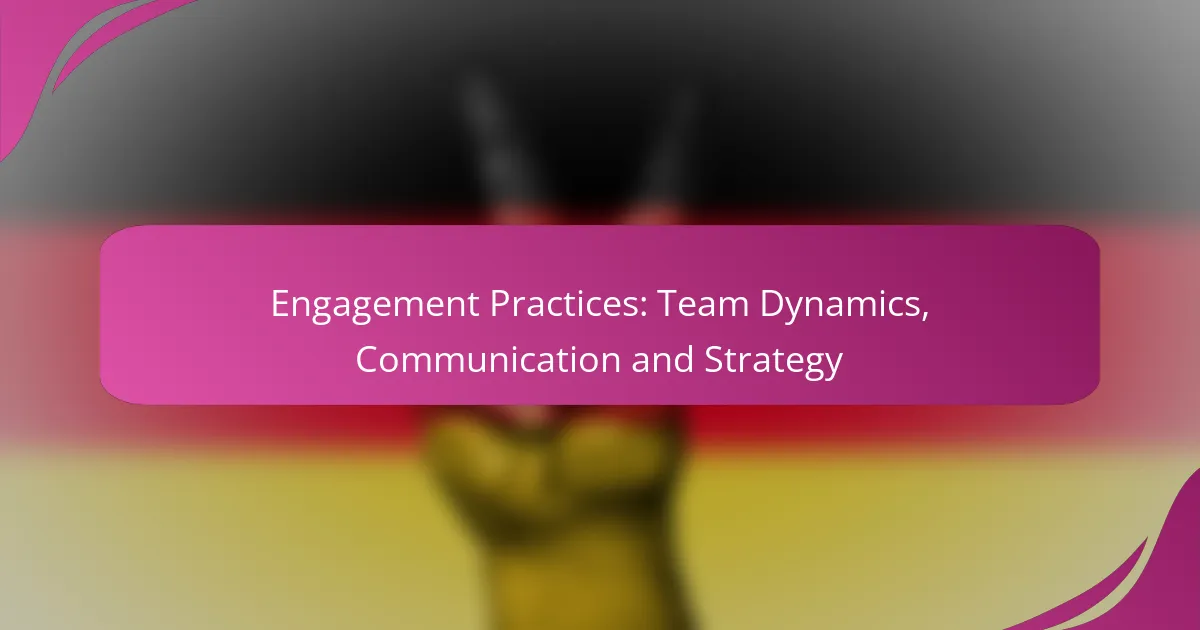Engagement practices play a crucial role in shaping team dynamics, enhancing communication, and formulating effective strategies within the workplace. By fostering a collaborative environment built on trust and open dialogue, teams can significantly improve their effectiveness and morale. Implementing targeted communication strategies not only facilitates clear exchanges of information but also aligns team objectives with both employee needs and organizational goals.
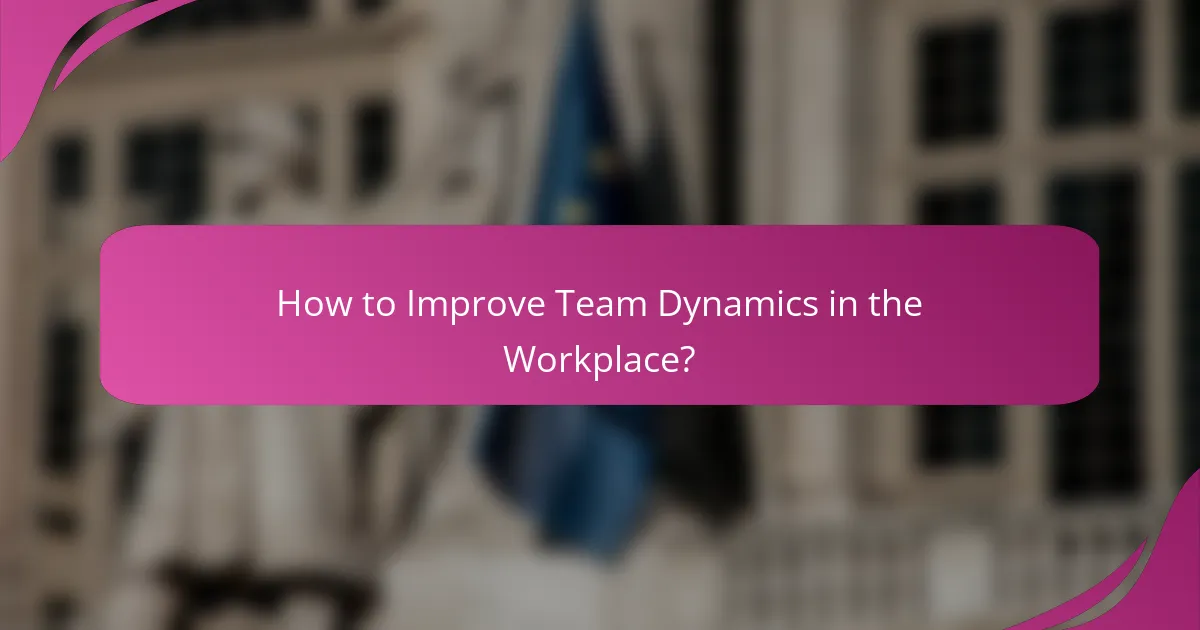
How to Improve Team Dynamics in the Workplace?
Improving team dynamics in the workplace involves fostering a collaborative environment where trust and open communication thrive. By implementing specific strategies, teams can enhance their effectiveness and overall morale.
Foster Trust and Collaboration
Building trust among team members is crucial for effective collaboration. Encourage transparency by sharing information and acknowledging each member’s contributions, which can create a sense of belonging and mutual respect.
Consider establishing team norms that promote supportive behaviors, such as active listening and constructive feedback. Regularly recognizing individual and team achievements can further strengthen trust and collaboration.
Implement Regular Team-Building Activities
Team-building activities are essential for enhancing relationships and improving teamwork. These can range from informal gatherings, such as lunches or outings, to structured workshops focused on specific skills.
Choose activities that align with your team’s interests and objectives. Aim for a mix of fun and purposeful exercises, ensuring that everyone feels included. Regularly scheduled events can help maintain a strong team bond over time.
Encourage Open Communication
Open communication is vital for addressing issues and fostering a positive team environment. Create channels for team members to express their thoughts and concerns freely, whether through regular meetings or anonymous feedback tools.
Encourage a culture where questions and discussions are welcomed. This can be achieved by modeling open communication from leadership and providing training on effective communication techniques.
Utilize Feedback Mechanisms
Implementing feedback mechanisms allows teams to continuously improve their dynamics. Regular check-ins and performance reviews can help identify areas for growth and reinforce positive behaviors.
Consider using surveys or one-on-one meetings to gather insights from team members. Ensure that feedback is constructive and actionable, and follow up on suggestions to demonstrate that team input is valued and taken seriously.

What Are Effective Communication Strategies?
Effective communication strategies are methods that facilitate clear and efficient exchanges of information within a team. These strategies enhance collaboration, reduce misunderstandings, and ultimately contribute to achieving team goals.
Adopt Clear Messaging Techniques
Clear messaging techniques involve using straightforward language and avoiding jargon to ensure everyone understands the information being shared. This can include defining key terms and summarizing complex ideas into simple concepts.
One effective approach is the “KISS” principle, which stands for “Keep It Simple, Stupid.” This encourages team members to convey their messages in the simplest way possible, making it easier for all to grasp the content quickly.
Additionally, using visual aids like charts or bullet points can help clarify messages and make them more memorable. Regularly soliciting feedback on communication clarity can also identify areas for improvement.
Leverage Digital Communication Tools
Digital communication tools enhance team interactions by providing various platforms for sharing information and collaborating in real-time. Tools like Slack, Microsoft Teams, or Zoom can facilitate instant messaging, video calls, and file sharing, making communication seamless.
When selecting tools, consider the specific needs of your team. For instance, if your team is remote, video conferencing tools may be essential for maintaining personal connections. Ensure that all team members are trained on how to use these tools effectively to maximize their benefits.
Establishing guidelines for tool usage, such as response times and appropriate channels for different types of communication, can help streamline interactions and reduce confusion.
Establish Regular Check-Ins
Regular check-ins are scheduled meetings that provide opportunities for team members to discuss progress, address challenges, and align on goals. These meetings can be daily, weekly, or bi-weekly, depending on the team’s needs and project timelines.
During check-ins, encourage open dialogue and active participation from all members. This not only fosters a sense of belonging but also ensures that everyone is on the same page regarding project developments and expectations.
To make the most of check-ins, set a clear agenda and stick to it. Consider using a rotating facilitator to keep the meetings engaging and allow different perspectives to emerge. This practice can significantly enhance team dynamics and communication flow.

How to Develop a Winning Engagement Strategy?
To develop a winning engagement strategy, focus on aligning your team’s objectives with employee needs and organizational goals. This involves creating a structured approach that fosters communication, collaboration, and motivation among team members.
Define Clear Objectives and Goals
Establishing clear objectives and goals is essential for a successful engagement strategy. These goals should be specific, measurable, achievable, relevant, and time-bound (SMART). For instance, aim to improve team collaboration by 20% within six months through regular feedback sessions and team-building activities.
Ensure that all team members understand these objectives and how their roles contribute to achieving them. This clarity helps in maintaining focus and accountability, ultimately driving engagement.
Incorporate Employee Input
Incorporating employee input is vital for fostering a sense of ownership and commitment. Regularly solicit feedback through surveys, suggestion boxes, or team meetings to understand their perspectives and ideas. This practice not only enhances engagement but also leads to innovative solutions.
Consider forming focus groups that represent diverse roles within the organization. This diversity can provide richer insights and help tailor the engagement strategy to meet the varied needs of your workforce.
Measure Engagement Metrics
Measuring engagement metrics allows you to assess the effectiveness of your strategy. Key metrics may include employee satisfaction scores, turnover rates, and participation in engagement initiatives. Regularly tracking these metrics helps identify areas for improvement.
Utilize tools like employee engagement surveys and performance reviews to gather data. Aim to review these metrics quarterly to ensure your strategy remains relevant and effective, making adjustments as necessary based on the findings.
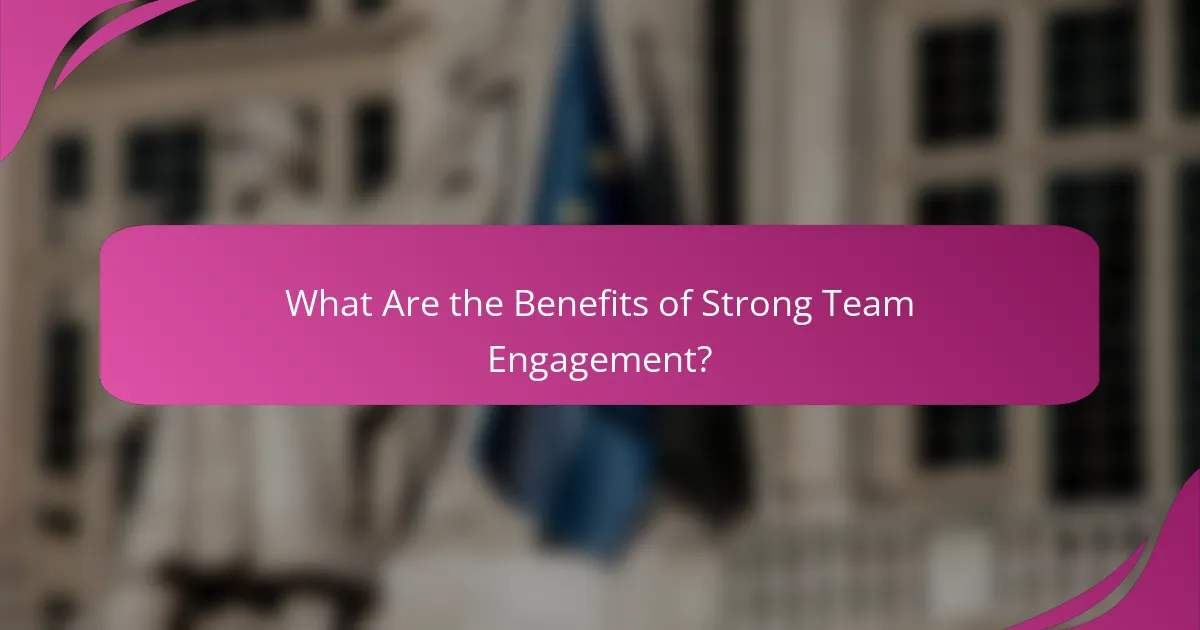
What Are the Benefits of Strong Team Engagement?
Strong team engagement leads to improved collaboration, higher morale, and better overall performance. When team members are actively engaged, they contribute more effectively to shared goals, fostering a positive work environment.
Increased Productivity
Strong team engagement significantly boosts productivity by encouraging collaboration and accountability. Engaged employees are more likely to take initiative, share ideas, and work efficiently towards common objectives.
For example, teams that hold regular check-ins and brainstorming sessions often see a marked improvement in project completion times. Implementing tools for real-time communication can further enhance this productivity by reducing delays in information sharing.
Enhanced Employee Satisfaction
When team members feel engaged, their job satisfaction tends to increase, leading to a more positive workplace atmosphere. Engaged employees are often more motivated and committed to their roles, which can translate into better performance.
To enhance satisfaction, organizations can implement feedback mechanisms and recognition programs. Simple gestures, such as acknowledging achievements in team meetings, can significantly boost morale and foster a sense of belonging.
Lower Turnover Rates
Strong engagement is linked to lower turnover rates, as employees who feel valued are less likely to seek opportunities elsewhere. High turnover can be costly, impacting team dynamics and organizational knowledge.
To retain talent, companies should focus on creating a supportive culture and providing growth opportunities. Regularly assessing employee engagement through surveys can help identify areas for improvement, ultimately leading to a more stable workforce.
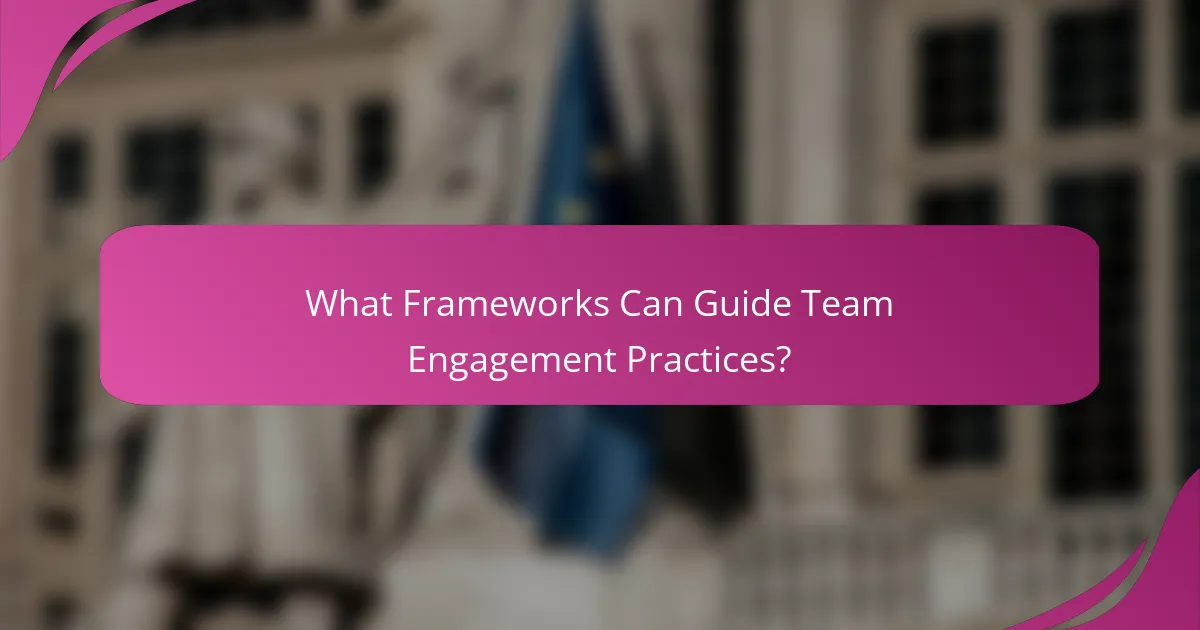
What Frameworks Can Guide Team Engagement Practices?
Effective team engagement practices can be guided by established frameworks that enhance collaboration and communication. Utilizing models like the Tuckman Model and the Five Dysfunctions of a Team can help identify areas for improvement and foster a more cohesive team environment.
Utilize the Tuckman Model
The Tuckman Model outlines the stages of team development: forming, storming, norming, performing, and adjourning. Understanding these phases helps teams navigate their dynamics and improve engagement at each stage.
During the forming stage, team members get to know each other and establish initial relationships. As they progress to storming, conflicts may arise as individuals assert their ideas. Facilitating open communication during this phase is crucial to move towards norming, where team norms and roles are established.
In the performing stage, teams operate efficiently towards shared goals. Regular check-ins can help maintain momentum, while the adjourning phase allows for reflection on accomplishments and lessons learned. Consider using team-building activities to strengthen relationships throughout these stages.
Apply the Five Dysfunctions of a Team
The Five Dysfunctions of a Team framework identifies common pitfalls that hinder team effectiveness: absence of trust, fear of conflict, lack of commitment, avoidance of accountability, and inattention to results. Addressing these dysfunctions is essential for fostering a high-performing team.
Building trust is the foundation of a successful team. Encourage vulnerability by sharing personal experiences and challenges. To address fear of conflict, create a safe space for open discussions where differing opinions are valued. This can lead to greater commitment as team members feel heard and involved in decision-making.
Establish clear accountability measures to ensure everyone is responsible for their contributions. Regularly review team goals and results to maintain focus on collective outcomes. Implementing these strategies can significantly enhance team engagement and performance over time.
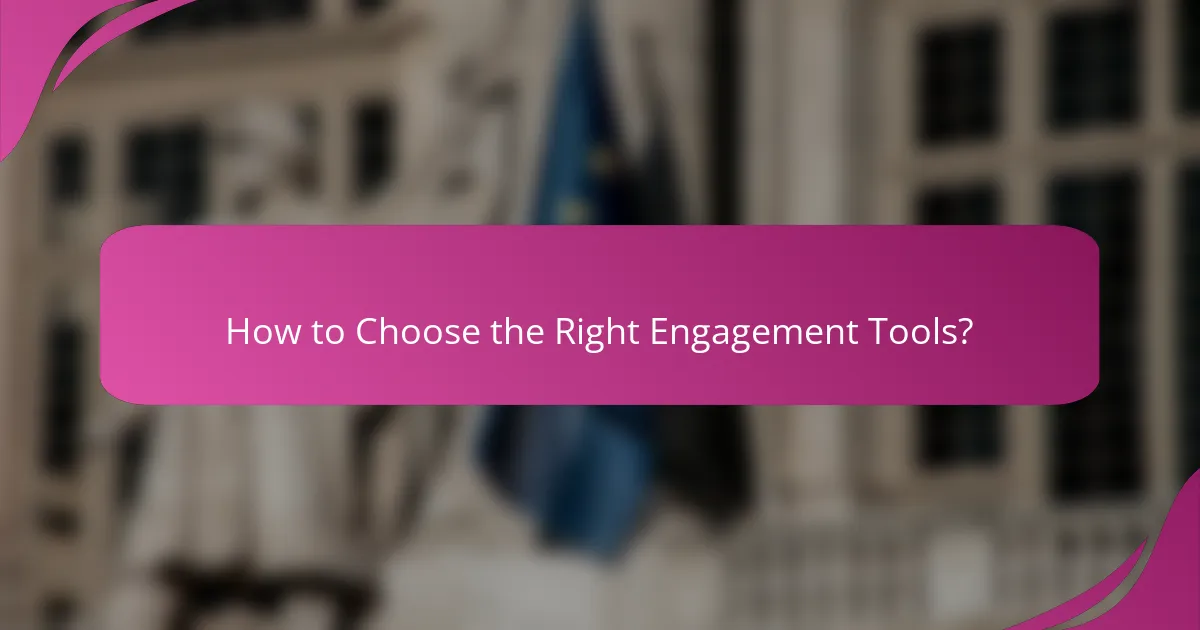
How to Choose the Right Engagement Tools?
Selecting the right engagement tools involves understanding your team’s specific needs and dynamics. Consider factors such as team size, communication preferences, and the nature of your projects to ensure effective collaboration.
Assess Team Size and Structure
Understanding your team’s size and structure is crucial when choosing engagement tools. Smaller teams may benefit from simple, straightforward tools that facilitate direct communication, while larger teams might require more robust platforms that support diverse workflows and integrate various functionalities.
For teams of up to 10 members, tools like Slack or Microsoft Teams can enhance communication without overwhelming users. In contrast, teams exceeding 20 members may need project management software like Asana or Trello to manage tasks and maintain clarity across multiple projects.
Evaluate how your team is organized—whether in departments, cross-functional groups, or remote setups. This will help you determine if you need tools that support hierarchical communication or those that promote collaborative environments.
